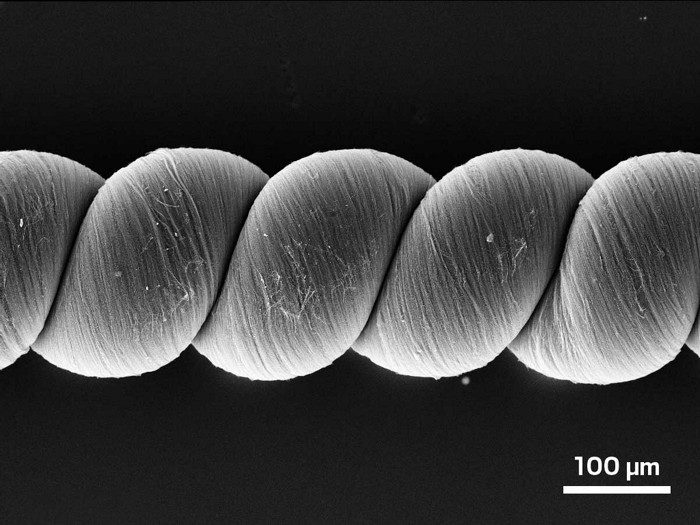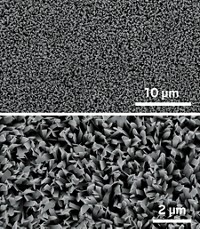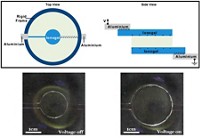Advertisement
Grab your lab coat. Let's get started
Welcome!
Welcome!
Create an account below to get 6 C&EN articles per month, receive newsletters and more - all free.
It seems this is your first time logging in online. Please enter the following information to continue.
As an ACS member you automatically get access to this site. All we need is few more details to create your reading experience.
Not you? Sign in with a different account.
Not you? Sign in with a different account.
ERROR 1
ERROR 1
ERROR 2
ERROR 2
ERROR 2
ERROR 2
ERROR 2
Password and Confirm password must match.
If you have an ACS member number, please enter it here so we can link this account to your membership. (optional)
ERROR 2
ACS values your privacy. By submitting your information, you are gaining access to C&EN and subscribing to our weekly newsletter. We use the information you provide to make your reading experience better, and we will never sell your data to third party members.
Materials
Twisted fibers strengthen artificial muscles
Three groups report polymer yarns that respond to electrical, thermal, or chemical stimuli, which may find use in robots and medical devices
by Mark Peplow, special to C&EN
July 17, 2019
| A version of this story appeared in
Volume 97, Issue 29

Artificial muscles made from twisted fibers could offer a compact and lightweight alternative to conventional motors in applications such as miniature robots or medical implants. But these synthetic sinews face a series of challenges: some rely on expensive materials, or are difficult to mass-produce, while others are simply too feeble.
Now, three research groups have independently created fibers that pack more power in their twists and coils, and harness electrical, thermal or chemical energy to lift weights or turn propellers. Their designs could pave the way for muscles that are cheaper, stronger, and amenable to large-scale manufacture, says Sameh Tawfick, a mechanical engineer at the University of Illinois at Urbana-Champaign, who works on artificial muscles and was not involved in these studies.
“The community is embracing the idea of using coiled or twisted fibers in these muscles,” Tawfick says. “As these fibers become a reality, we’re about to see a big transformation in how we design machines.”

Some of the strongest artificial muscles to date have relied on carbon nanotube yarns that incorporate a responsive partner material. An external stimulus, such as heating or exposure to a chemical, changes the partner material’s volume and forces the yarn to untwist so that it can do useful work.
But nanotubes are pricey, and the muscle’s mechanical power is often limited because the external stimulus cannot reach material in the fiber’s inner core, says Ray H. Baughman at the University of Texas at Dallas. So his team has redesigned the composite fibers, wrapping a responsive polymer sheath around inexpensive yarn cores such as silk or polyacrylonitrile, and then twisting them tight before the coating dries (Science 2019, DOI: 10.1126/science.aaw2403).
In one example, a sheath containing poly(ethylene oxide) and a tetrafluoroethylene-sulfonyl fluoride vinyl ether copolymer could untwist when exposed to ethanol vapor, and then twist back to its original shape once the vapour was removed, thousands of times over.
An electroresponsive fiber, made from an electrolyte-filled carbon nanotube sheath around a nylon core, had 40 times more lifting power than a human muscle of the same size, far better than previous electrochemical muscles, Baughman says. The researchers also created a fiber that contracted in response to glucose, which they suggest could be used as a sensor to open or close the valves of a drug-delivery device inside the body.

Meanwhile, a team led by Philippe Poulin at the University of Bordeaux used a wet-spinning technique—widely used to mass-manufacture polymer fibers—to create artificial muscles from polyvinyl alcohol and flakes of graphene oxide (Science 2019, DOI: 10.1126/science.aaw3722). The researchers heated the fiber to 100 °C, twisted it tightly, and then cooled it to room temperature to lock the material into its coiled structure. When the researchers heat this “shape memory” fiber again, it untwists to its original straight shape. Graphene oxide makes the fiber stiffer, stronger and tougher, so that it can be twisted more tightly and store more energy without breaking, enabling it to do more work as it untwists.
“It’s a rather simple structure but with extremely high energy density,” Poulin says. The researchers used 100-μm-diameter fibers to form a 12 cm yarn, and hooked it up to a toy boat. Placed in a bath of silicone oil at 100 °C, the fibers untwisted rapidly and turned a propeller that sent the boat shooting along the bath.
Although the fiber can only untwist once, the team aims to develop blends of other materials, such as block copolymers, that could twist back and forth many times. “By having more complex structures, we can have more complex responses,” Poulin says.
The third team, led by Polina Anikeeva at Massachusetts Institute of Technology, created artificial muscles that were inspired by the architecture of cucumber tendrils, the curling threads that pull the plant toward sunlight. Each muscle fiber contains a sandwich of two materials, with polyethylene on one side and a cyclic olefin copolymer elastomer on the other. After the material is synthesized and drawn out, the elastomer contracts and pulls the fiber into a coil. Because the two materials also have very different thermal properties, heating the fiber makes them change shape at different rates, causing the coiled fiber to contract even more (Science 2019, DOI: 10.1126/science.aaw2502).
The fibers are so responsive that a temperature change of just 14 °C caused a 50% contraction in a 1 mm wide fiber. Once the heat was removed, the fiber immediately relaxed back to its previous shape. The fibers can perform thousands of these cycles, contracting much more quickly than previous artificial muscles, and can lift 650 times their own weight. Anikeeva aims to integrate thread-like heating elements into the fibers, so that they could eventually be used in prosthetic limbs or surgical robots that work in confined environments such as arteries.
Perhaps the main hurdle for all these artificial muscle fibers is that their energy efficiency still stands at just a few percent, Tawfick says. Fine-tuning the fibers’ chemistry could help address that. “We have barely even scratched the surface,” Anikeeva agrees. “There are many, many materials that can be incorporated into a fiber that could improve their performance.”





Join the conversation
Contact the reporter
Submit a Letter to the Editor for publication
Engage with us on Twitter